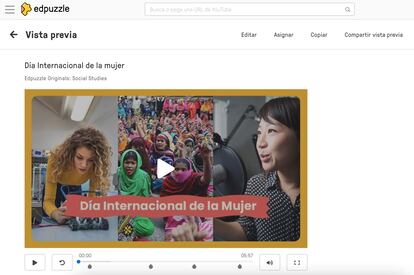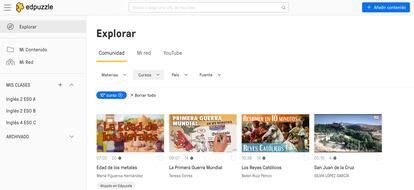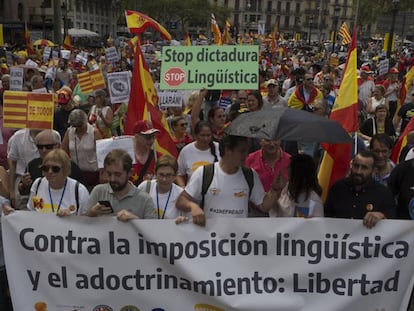The Spanish education platform taking the US by storm
The program, which uses interactive videos to teach students, has become popular across the world and is now present in 150 different countries
The Spanish learning platform Edpuzzle is taking off in the United States. It is used consistently by at least one teacher in 80% of schools, while in Spain, 11,000 schools are actively using the program. In total, it has spread to 150 different countries. Edpuzzle allows teachers to edit educational videos that present students with questions that they must answer either in writing or by responding out loud. In 2017, Forbes magazine included its four founders – Quim Sabrià, Jordi González, Santi Herrero and Xavi Vergés – in its 30 under 30 list of top young entrepreneurs in Europe.
The idea for Edpuzzle came from an unexpected need. In 2012, Sabrià was doing an internship to become a secondary school teacher at a school in Badalona, in Spain’s northeastern region of Catalonia. The school had a problem with absenteeism, and the teenagers were disinterested in class. “Teaching classes was very enriching, but very, very difficult,” recalls Sabrià by video call from California. However, “things fell into place by fate,” he says. By chance, three of his childhood friends, Jordi González, Santi Herrero and Xavi Vergés – who he met when he was just three years old – had gone on to become telecommunications engineers. He would tell them about his “battles in class with the students” and wonder what he could do to keep his students interested. They all agreed on the answer: audiovisual material.
“When a student doesn’t understand something, they go to YouTube, not to a library. Videos are the best way to connect with your students,” says Sabrià. His three engineering friends wanted to translate what they knew about building web pages into a teaching platform for him. “It’s very difficult to say no if someone offers to make a tool for your class,” he adds.
But Sabrià wanted to do more than just share YouTube videos, which he says promotes “passive behavior.” “With Edpuzzle, by embedding questions, the student has to think, respond,” he explains. The teacher can edit other people’s videos or create their own, which other teachers may then use.

Rosa Liarte, a history teacher at an institute in Fuengirola, in the southern Spanish province of Málaga, says she was a “fan from the beginning” of Edpuzzle. She says that she does not agree with the argument that technology dehumanizes education. “On the contrary, it brings me closer to my students,” she explains. “What I would explain in 20 minutes, they can see in a seven-minute video and I can use the class to do other projects.” Liarte estimates that about 20 teachers, out of a faculty of 37, use Edpuzzle in her school.
In 2013, the founders of Edpuzzle decided to make the leap and move to the United States in search of funding. “We didn’t think twice,” says Sabriá. “The difference [between the US and Spain] was very significant. Earlier, they gave you $100,000 [€92,000] – now it’s half a million – and in exchange, you gave them 6% of the company. And in Spain, it was €25,000 [$27,000] and they kept a very high percentage.” That year the four settled in Mountain View, south of San Francisco, near Google’s headquarters, with the support of startup accelerator Y Combinator – which previously backed Dropbox and Airbnb. In separate funding rounds, Edpuzzle raised up to $4 million (€3.4 million) to get started.
“We decided to treat the first 10 users better than our mothers. I’m a friend, I’ve been to their birthdays, to their houses,” says Sabrià laughing. “I was going to visit them with coffee and cookies every Friday to find out how the week had gone, how the students had responded.” Edpuzzle is free to use, but to store many videos there is a monthly fee of $12.50 (€11.50) per teacher or between $1,080 (€1,000) and $1,620 (€1,500) per year per school (depending on the size).
That same year, the three engineers returned to Barcelona and opened a second office in the city. Of the quartet, only Sabrià remained in California. Before the coronavirus pandemic, there were 40 workers in the Spain and US headquarters. Now, just the office in California has 62 employees. During the health crisis, which saw millions of students move to remote learning, demand for Edpuzzle skyrocketed: the number of teachers who use the platform rose elevenfold.
The first effects of the pandemic were detected when Hong Kong was confined in mid-February 2020. “Overnight, we went from being used in zero to 100 schools,” says Sabrià. “On Monday they had to teach and the teachers were desperate.”

Edpuzzle is now looking to grow its presence in Argentina, Brazil, Spain, France, Hong Kong and Australia. The platform, which they intend to translate into at least 15 languages, was free during the worst moment of the pandemic and its founders continue to support social causes. In response to the Russian invasion of Ukraine, they have developed content in Ukrainian to help teach children who are refugees or who are studying remotely. “We already have math and science videos,” says Sabrià. But these are not the only subjects that can be found on Edpuzzle, he adds, explaining that videos on nutrition and physical education are also available.
What’s more, while most of the videos are aimed at students in their last years of elementary school and high school, there is also university-level material, such as a video on astrophysics from the Massachusetts Institute of Technology (MIT). And they are building a global community of teachers so that professors can build upon the work of their colleagues.
Tu suscripción se está usando en otro dispositivo
¿Quieres añadir otro usuario a tu suscripción?
Si continúas leyendo en este dispositivo, no se podrá leer en el otro.
FlechaTu suscripción se está usando en otro dispositivo y solo puedes acceder a EL PAÍS desde un dispositivo a la vez.
Si quieres compartir tu cuenta, cambia tu suscripción a la modalidad Premium, así podrás añadir otro usuario. Cada uno accederá con su propia cuenta de email, lo que os permitirá personalizar vuestra experiencia en EL PAÍS.
¿Tienes una suscripción de empresa? Accede aquí para contratar más cuentas.
En el caso de no saber quién está usando tu cuenta, te recomendamos cambiar tu contraseña aquí.
Si decides continuar compartiendo tu cuenta, este mensaje se mostrará en tu dispositivo y en el de la otra persona que está usando tu cuenta de forma indefinida, afectando a tu experiencia de lectura. Puedes consultar aquí los términos y condiciones de la suscripción digital.
More information
Últimas noticias
There is as much life left to discover on planet Earth as that which is already known
Dozens presumed dead, around 100 injured in fire at Swiss Alps bar during New Year’s celebration
Is porn for women different from conventional porn? We spoke to those who make it
Cartagena de Indias is sinking: What can the city do to mitigate it?
Most viewed
- Reinhard Genzel, Nobel laureate in physics: ‘One-minute videos will never give you the truth’
- David King, chemist: ‘There are scientists studying how to cool the planet; nobody should stop these experiments from happening’
- Oona Chaplin: ‘I told James Cameron that I was living in a treehouse and starting a permaculture project with a friend’
- Sinaloa Cartel war is taking its toll on Los Chapitos
- The Interoceanic Train, the Mexican alternative to the Panama Canal











































